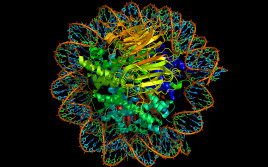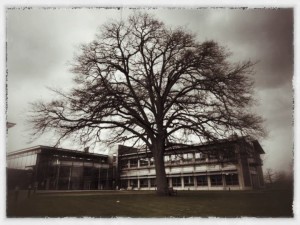Transcript
On the outskirts of Cambridge sits the Wellcome Trust Sanger Institute, one of the world’s largest organisations dedicated to genetics research. The institute is named after Fred Sanger, the Nobel laureate who developed DNA sequencing technology in the 1970s. Sanger’s techniques are still in use today, albeit now powered by super processors.
DNA. We’ve all got it, and we’re constantly told by scientists and newspaper articles – indeed, science podcasts – that it’s the blueprint for building a living organism. There’s a version of this twisty molecule in virtually every cell in the human body and in many ways it controls our destiny – DNA contains the instructions for how many fingers your hand should grow, what colour eyes you dazzle the world with and it can even be used to predict your likelihood of cancer. Ever since biologists finished, ten years ago, reading the entire human genome – the full sequence of genes that is unique to humans – they have realised how complicated genetic material actually is
The thing about genetic material is that although it’s really small, we CAN read it and even transcribe it using the letters, A, T, C and G. It’s a bit like how digital code is always a series of 0s and 1s. And one chap who worked out HOW to read the code is Fred Sanger, whose name is now encoded into genetic-speak on a stained glass window at the institute that bears his name. The Wellcome Trust Sanger Institute, just outside Cambridge, employs hundreds of scientists all working on various elements of genetics research.
They recently produced the first full sequence of the gorilla genome – that is, all the genes that make gorillas gorillas. The reason why scientists at Sanger and elsewhere sequence genomes is that the results tell them all about how that species became a distinct species, including when it diverged from its evolutionary cousins, and why it is the way it is today. For example, as you’ll hear later on, studying the genes of the malaria parasite carried by mosquitoes reveal just how it is able to penetrate a person’s red blood cells to infect them. If an organism were a car, its genome would be the Haynes owners’ manual, detailing everything about how it works. But genomes are much more complex than cars, and they take the form of the very small and very long molecule DNA. Only with machines can we sequence all the genes in an organism’s genome. That is why, on a recent tour of Sanger by the institute’s media and public relations manager Don Powell took me not to a lab with scientists at workbenches but a room full of giant computers…
This podcast was produced and presented by science journalist, Adam Smith. Check out his Guardian blog, Science and politics: chalk and cheese? And follow Adam on Twitter @AdamCommentism
Interviewees
Links
Wellcome Trust Sanger Institute
Molecular biology databases
Pfam 10 years on: 10,000 Families and still Growing, (PMID:18344544), Sammut SJ, Finn RD, Bateman A, Briefings in Bioinformatics [2008, 9(3):210-9].
MEROPS: thepeptidasedatabase, (PMID:17991683), Rawlings ND, Morton FR, Kok CY, Kong J, et al., Nucleic Acids Research [2008, 36(Database issue):D320-5].
ThePfamproteinfamiliesdatabase, (PMID:18039703), Finn RD, Tate J, Mistry J, Coggill PC, et al., Nucleic Acids Research [2008, 36(Database issue):D281-8]
Malaria research
BasiginisareceptoressentialforerythrocyteinvasionbyPlasmodiumfalciparum, (PMID:22080952), Crosnier C, Bustamante LY, Bartholdson SJ, Bei AK, et al., Nature [2011, 480(7378):534-7].
Ascalablepipelineforhighlyeffectivegeneticmodificationofamalariaparasite, (PMID:22020067), Pfander C, Anar B, Schwach F, Otto TD, et al., Nature Methods [2011, 8(12):1078-82].
Gorilla genome
Insightsintohominidevolutionfromthegorillagenomesequence. Scally A et al., Nature [2012, 483:169–175].
Boffinsunlockgorillagenome, findlazyspermgene
Lastgreatapegenomesequenced
David Bradley



Subscribe with…